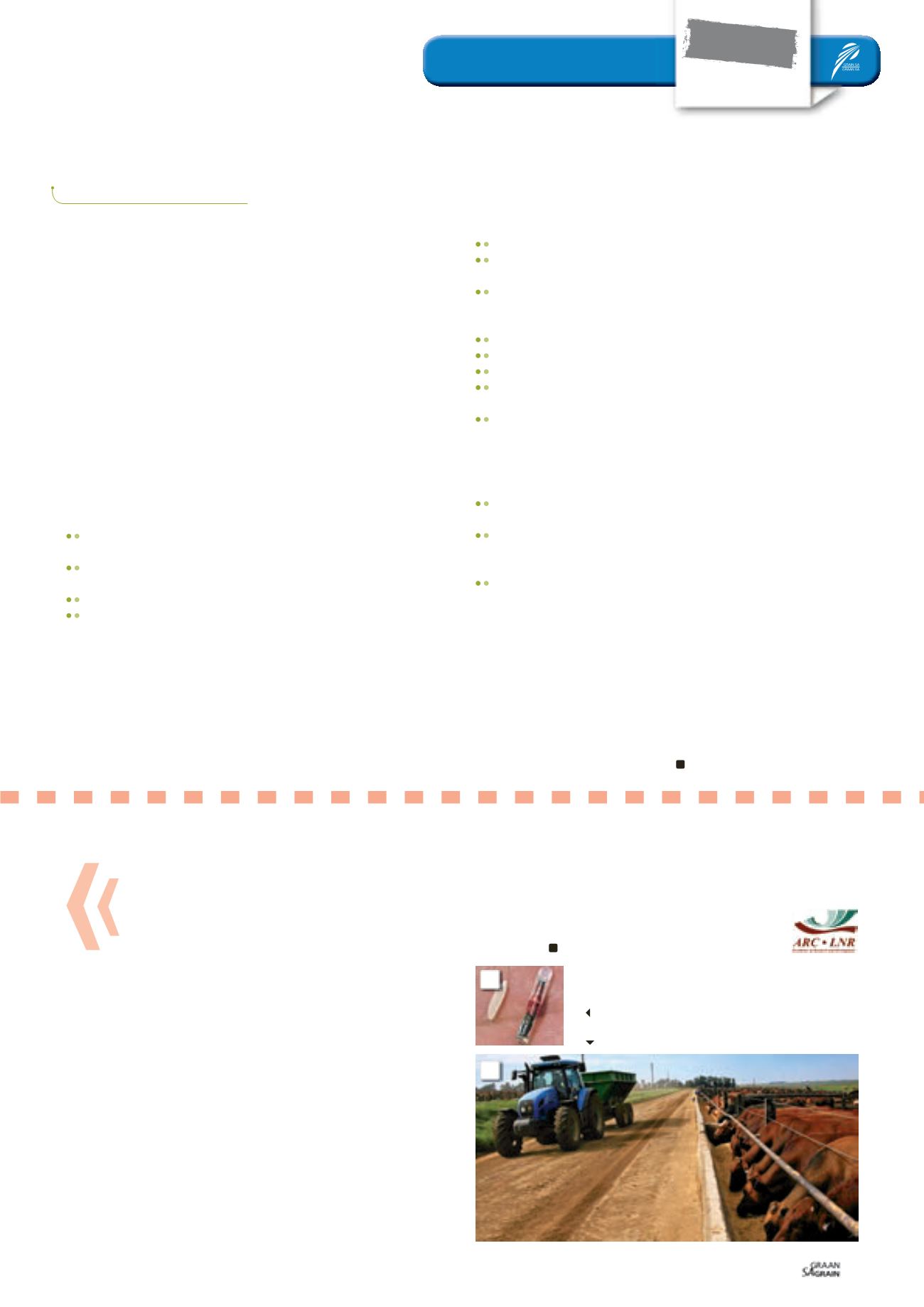

Product information
Pneumonia in sheep
R
espiratory disease usually begins when an animal is stress-
ed. Stress from overcrowding, transportation, adverse
weather, lambing or other factors such as castration or tail
docking weakens the immune system. This then predis-
poses animals to viral infections, which sets the stage for infection
with bacteria that can settle in the lungs and cause severe damage.
Animals affected
All sheep are susceptible to respiratory disease. This however
increases in situations of stress. Respiratory disease, especially Pas-
teurellosis, is most often seen in young stock that has encounter-
ed multiple stresses. It is also a problem in all sheep when conditions
are dry and dusty. Contributing factors are: Overcrowding; dust;
poor ventilation; transportation; lack of adequate feed or water;
weather extremes including heat, cold and moisture; and lambing.
Causes
Pneumonia in lambs can be caused by bacteria, mycoplasma and
viruses:
Bacteria:
Mannheimia haemolytica
(formerly
Pasteurella haemo-
lytica
) and
Pasteurella
spp.
Viruses:
Parainfluenza
-type 3 (PI-3),
Adeno
-virus, and
Respira-
tory syncytial
virus
Mycoplasma
spp.
Lungworm (
Dictyocaulus filarial
)
Clinical signs are poor appetite, fever, depression (stand alone with
head down; slow to move or get up), runny nose, discharge from
eyes (inflammation), coughing, difficulty breathing and wheezing.
Disease management: Prevention
The key to preventing respiratory disease is to reduce stress and
to vaccinate against bacteria that cause disease. Currently no
registered viral vaccines are available for sheep.
To reduce stress
Handle animals with care
Provide adequate rest, feed and water (especially after trans-
portation)
Minimise exposure to environmental conditions that contribute
to disease, such as dust, crowding and fumes and maintain good
housing and ventilation
Avoid overcrowding
Minimise heat stress
Keep animals as clean and dry as possible
Nutritional soundness also helps prevent disease and improve
immune function
Make sure animals receive adequate levels of vitamins and
minerals
Vaccination
A respiratory vaccination programme should include at least:
Mannheimia haemolytica
: Consider One Shot Ultra™ 7 Reg.
No. G2818 (Act 36/1947)
Primary vaccination: Administer a single 1 ml dose of One Shot
Ultra 7 to healthy sheep followed by a second dose of Ultra
Choice 7 (Reg. No. 2804 [Act 36/1947]), four to six weeks later
Revaccination: Annual revaccination with a single dose of One
Shot Ultra is recommended
Treatment
Viral infections do not respond to antibiotics; however these
products are effective against many secondary bacterial infections.
Long-acting antibiotics such as Terramycin®/LA – Reg. No. G333
(Act 36/1947) – provide multiple days of therapy.
Dosage: 1 ml/10 kg body mass by intramuscular injection. In
sheep over 50 kg, it is recommended that the dose be divided and
administered at two injection sites.
77
FOCUS
Animal health
Special
Daar is inderdaad sekere norms waaraan ‘n voerkraal moet voldoen.
Elke bees benodig ‘n sekere vreetspasie, staanspasie en besker-
ming teen die elemente.
Vir die voerkrip word ‘n minimumkriplengte van 150 mm per
bees benodig indien jong beeste
ad libitum
gevoer word. Ouer
beeste benodig ‘n langer kriplengte. Die aanbevole kriplengte in
aanpassingskrale is 300 mm per bees en die krippe by aanpas-
singskrale is ook vlakker.
Figuur 2
toon ‘n tipiese voerkripuitleg.
Die houkrale se ontwerp is net so belangrik. Sommige houkrale
kan rond wees en ander langwerpig of hoekig. Vir elke ontwerp is
daar sekere voor- en nadele. Ronde komplekse raak ook ‘n opsie
omdat dit goedkoper is om te bou en minder materiaal vereis.
Drukgange is ‘n integrale deel van ‘n voerkraal. Dit moet so ontwerp
word dat dit die hantering vergemaklik en die stres op diere
verminder. Tog moet dit sterk genoeg wees om jarelange diens te
verseker.
Die materiaal wat gebruik word om die fasiliteit mee te bou, is
baie belangrik. Baie plastiekgedeeltes kom in die omloop wat dalk
goedkoper en sterker as staal kan wees. Hierdie keuse moet ver-
seker met groot oorleg geneem word.
‘n Volledige handleiding oor vleisbeesfasiliteite is beskikbaar by die
LNR-Instituut vir Landbou-ingenieurswese. Hierdie handleiding kan
help om beter idees te verkry en te implementeer.
Kontak Elmarie Stoltz by 012 842 4017 of
stoltze@arc.agric.za
vir meer inligting oor hierdie insiggewende
handleiding.
Funksionele
vleisbeesvoerkrale
BARRY VAN HOUTEN,
Zoetis
March 2015
1: RFID-tegnologie word vergelyk met die grootte
van ‘n ryskorrel.
2: ‘n Tipiese voerkrip.
SA Graan/
Sasol Chemicals (Kunsmis) fotokompetisie
– Fred Beck 2014
1
2

















